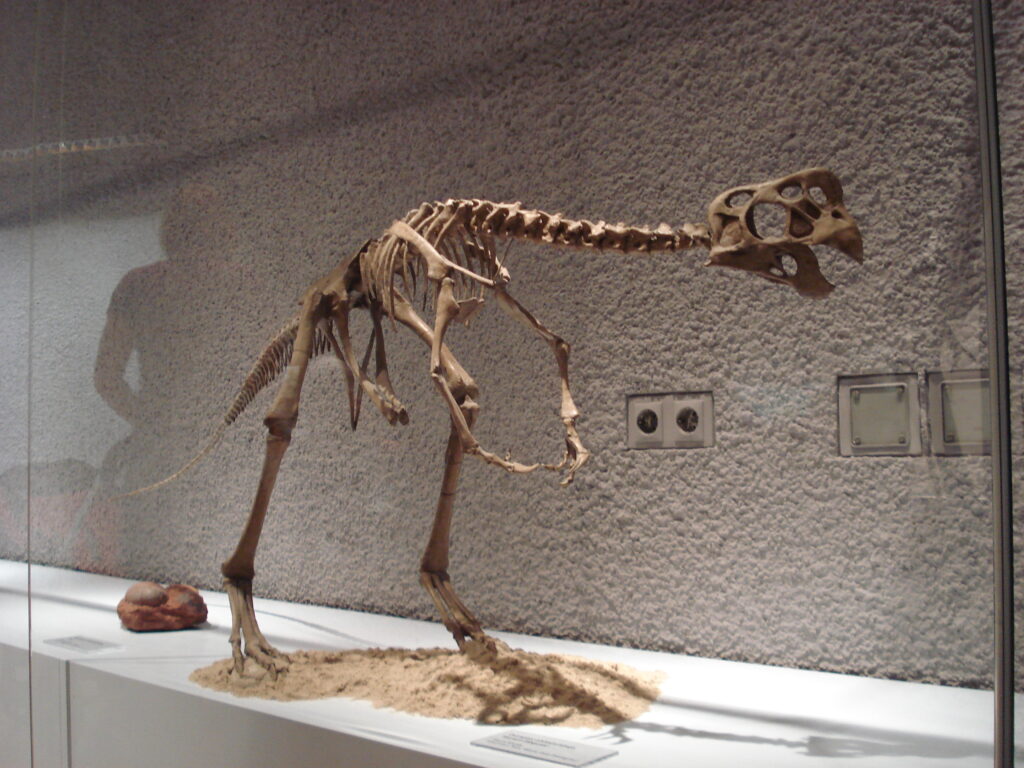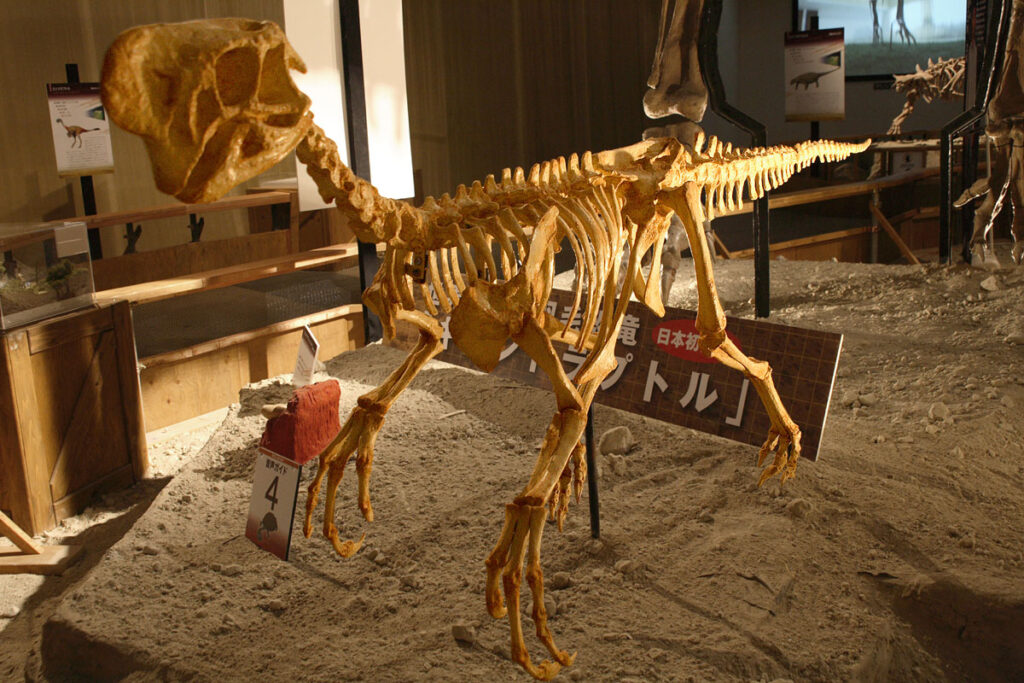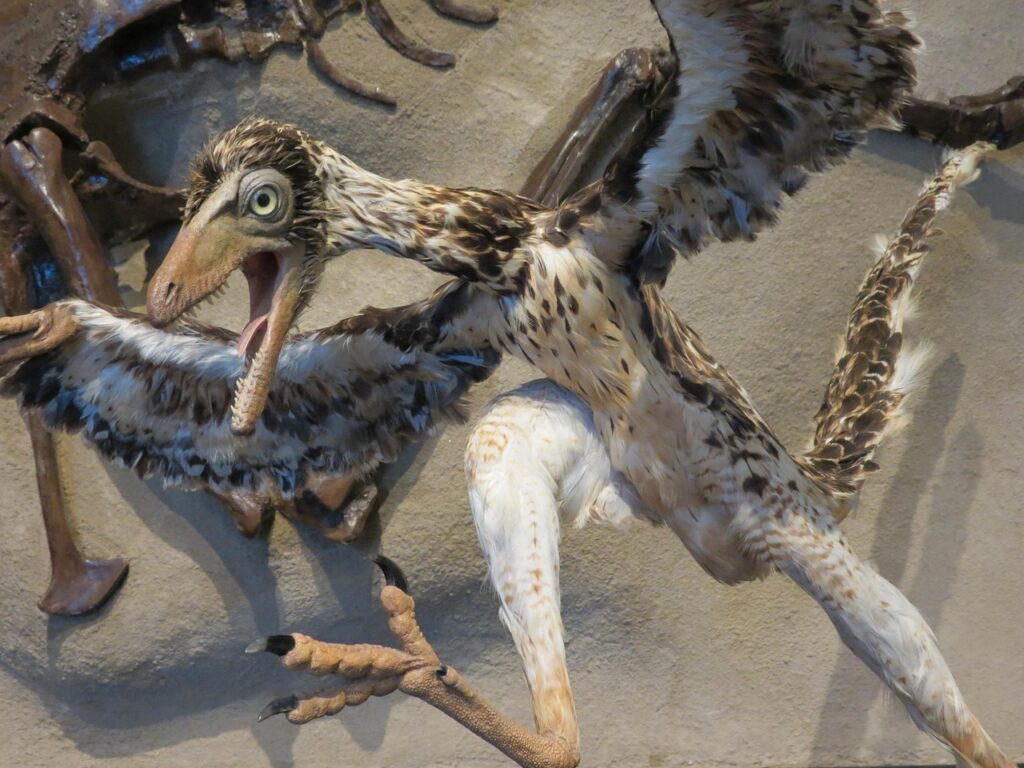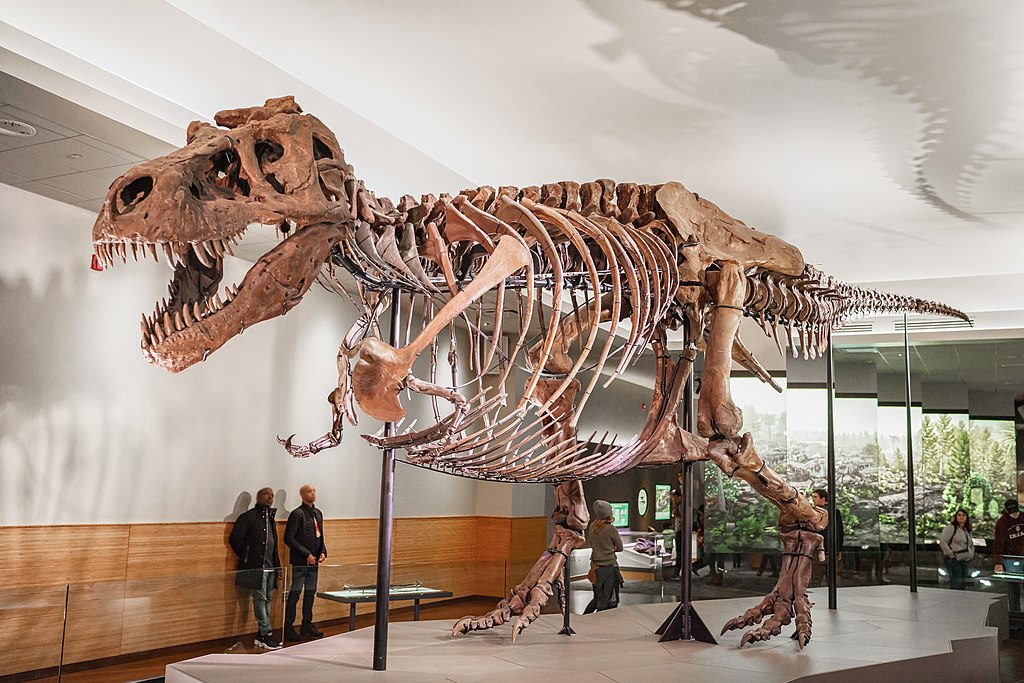When paleontologists first discovered the Oviraptor in 1924, they made a critical mistake. Found atop what appeared to be a nest of Protoceratops eggs, this dinosaur was branded an “egg thief” – the literal meaning of its scientific name. Yet decades later, we’ve learned this creature was no villain but rather a devoted parent. The misunderstood Oviraptor’s most distinctive feature – its unusual, parrot-like beak – has sparked scientific debates and revealed surprising insights about dinosaur evolution. This article delves into the fascinating story of the Oviraptor’s extraordinary beak, exploring its form, function, and the revolutionary understanding it has brought to paleontology.
The Troubled History of Oviraptor’s Discovery

The story of Oviraptor begins with a case of mistaken identity during the famous Central Asiatic Expeditions to Mongolia’s Gobi Desert in 1924. Led by Roy Chapman Andrews, the expedition unearthed a skeleton positioned directly above a nest of what were assumed to be Protoceratops eggs. Based on this positioning and its unusual beak-like mouth, paleontologist Henry Fairfield Osborn named the new dinosaur “Oviraptor philoceratops,” meaning “egg thief, lover of ceratopsians.” This hasty conclusion cast the dinosaur as a villain for decades in both scientific literature and popular culture. It wasn’t until the 1990s, when additional Oviraptor specimens were discovered in brooding positions over nests, that scientists realized the original Oviraptor wasn’t stealing eggs but protecting its own. This revelation completely transformed our understanding of this remarkable dinosaur and its distinctive beak.
Anatomy of an Unusual Mouth

The Oviraptor’s beak represents one of the most specialized feeding structures among non-avian dinosaurs. Unlike the typical toothed jaws of most theropod dinosaurs, Oviraptor possessed a toothless beak composed of keratin overlaying a complex bony structure. The upper jaw featured a tall, rounded crest that housed extended nasal passages, while the lower jaw was deep and powerful, creating a formidable biting apparatus. The beak curved downward at the tip, somewhat resembling modern parrots, though the evolutionary relationship is purely convergent. What makes this structure particularly unusual is how it combines aspects of beaks seen in various modern birds, but in a unique configuration not found in any living animal. Importantly, despite its name suggesting specialization for egg-eating, the beak’s structure indicates it was likely adapted for a different diet altogether.
The Misnamed “Egg Thief”

The scientific name “Oviraptor philoceratops” has become a classic example of premature scientific labeling. The initial interpretation that this dinosaur was stealing Protoceratops eggs led to its unfortunate moniker as an “egg thief.” However, modern discoveries have thoroughly debunked this characterization. In the 1990s, expeditions to Mongolia’s Gobi Desert uncovered multiple Oviraptor specimens positioned over nests in a brooding posture identical to that of nesting birds. Further analysis revealed that these eggs contained embryonic oviraptorids, not Protoceratops, confirming they were the parents’ offspring. This discovery revolutionized our understanding of dinosaur behavior, providing some of the strongest evidence for parental care among non-avian dinosaurs. Despite clear evidence exonerating the Oviraptor, its misleading name remains a permanent reminder of how scientific understanding evolves.
Advanced Cranial Features

The Oviraptor’s skull represents one of the most specialized and advanced cranial designs among dinosaurs. Beyond the distinctive beak, the skull featured numerous pneumatic openings – hollow spaces that likely reduced weight while maintaining structural integrity. Most striking was the tall sagittal crest on top of the skull, which varied significantly among different oviraptorid species. This crest contained extended nasal passages that may have served several functions, from vocalization to thermoregulation. CT scanning of Oviraptor skulls has revealed remarkably bird-like inner ear structures, suggesting these dinosaurs possessed keen balance and coordination. Additionally, the brain case shows enlarged optical lobes, indicating Oviraptor likely had excellent vision. These advanced cranial features paint a picture of a highly specialized dinosaur with sensory capabilities more reminiscent of modern birds than typical dinosaurs of its era.
Diet Debate: What Did Oviraptor Eat?

Despite its misleading name suggesting an egg diet, the Oviraptor’s feeding habits remain a subject of ongoing scientific debate. The unusual beak structure has led paleontologists to propose various dietary possibilities. Some evidence suggests Oviraptors may have been omnivorous, with a beak well-suited for processing tough plant material like seeds, nuts, and fruits. Other researchers point to the powerful jaw muscles and beak morphology as adaptations for crushing hard-shelled mollusks or other invertebrates that would have lived in the ancient Gobi ecosystem. Stomach contents from exceptionally preserved specimens have proven elusive, leaving diet speculation primarily based on morphological studies. Comparative analyses with modern bird beaks suggest versatility rather than extreme specialization, potentially indicating Oviraptors were dietary generalists. This adaptability may help explain the successful radiation of oviraptorids across Asia during the Late Cretaceous period.
Biting Force and Feeding Mechanics

The Oviraptor’s unusual beak wasn’t just for show – it represented a powerful feeding tool with remarkable biomechanical properties. Recent studies using finite element analysis have modeled the biting forces these dinosaurs could generate, revealing surprising strength. The deep, robust lower jaw housed significant muscle attachments that could produce powerful compressive forces at multiple points along the beak. Unlike many predatory dinosaurs that relied on slashing or piercing bites, Oviraptor’s beak was optimized for crushing and grinding motions. Particularly notable was the ability to exert force toward the back of the jaw, ideal for processing tough plant material or cracking shells. The beak’s downturned tip would have excelled at precision plucking, while the broad middle section could process larger items. This combination of strength and versatility suggests Oviraptors could exploit food resources unavailable to many contemporaneous dinosaurs, potentially explaining their evolutionary success.
Evolutionary Origins of the Beak

The evolution of the Oviraptor’s distinctive beak represents a fascinating case of convergent evolution with birds. While oviraptorids and modern birds both possess keratinous beaks, they evolved these features independently from toothed ancestors. Transitional fossils in the oviraptorid lineage show a gradual reduction of teeth and expansion of the beak-supporting bones, particularly the premaxilla and dentary. This transformation likely began in early maniraptoran theropods approximately 125-130 million years ago. Genetic studies of modern birds have identified key developmental pathways controlling beak formation, including the BMP4 and CaM genes. Paleontologists hypothesize that similar genetic mechanisms may have driven beak evolution in oviraptorids, representing a remarkable case of parallel evolution. The appearance of beaks in multiple dinosaur lineages, including oviraptorids, ornithomimids, and avialans, suggests this adaptation provided significant evolutionary advantages in various ecological niches during the Mesozoic era.
The Cranial Crest: Display or Function?

One of the most striking features of Oviraptor’s skull was the prominent cranial crest that extended vertically above its beak. This feature varied dramatically among oviraptorid species, with some displaying tall, elaborate crests and others having more modest structures. The primary debate centers on whether these crests served primarily as display structures or had physiological functions. Evidence supporting the display hypothesis comes from the varied shapes between species and even potential sexual dimorphism within species, suggesting they played roles in species recognition and mate selection. However, CT scans have revealed these crests contained elaborate nasal passages, suggesting possible roles in thermoregulation or sound production. These extended nasal chambers could have warmed inhaled air, conserved moisture, or even created distinctive vocalizations. Most likely, the crests served multiple functions simultaneously, combining practical physiological benefits with important social signaling capabilities in these highly visual dinosaurs.
Comparison to Modern Bird Beaks

The Oviraptor’s beak shows fascinating parallels with various modern birds, although these similarities arose through convergent evolution rather than direct ancestry. The robust, downturned shape bears surface resemblance to modern parrots, which use their powerful beaks to crack nuts and process tough plant materials. The broad, crushing surfaces also share functional similarities with seed-eating birds like grosbeaks and cardinals. However, key differences exist – Oviraptor’s beak lacked a true tomosynum (cutting edge) seen in many bird beaks and featured more extensive bone support than typical avian beaks. Modern birds display remarkable beak diversity, specialized for specific diets, from the filter-feeding spatulate bills of ducks to the probing beaks of sandpipers. The Oviraptor’s beak appears more generalized than these extreme specialists, suggesting it may have been adapted for dietary versatility rather than a highly specific food source. This comparison highlights both the remarkable convergence in beak evolution and the unique adaptations that distinguished dinosaurian beaks from their avian counterparts.
Oviraptor Species Diversity

The Oviraptoridae family encompasses remarkable diversity, with at least fifteen recognized genera displaying fascinating variations in their beak morphology. Citipati, often confused with Oviraptor in popular media, possessed a taller crest and slightly different beak proportions than the original Oviraptor philoceratops. The recently discovered Corythoraptor had an elaborate cassowary-like crest atop its skull that dramatically altered its appearance. Some genera like Nemegtomaia featured more robust, deeper beaks, which are likely adapted for processing different food resources. Geographical variations are evident as well, with Chinese oviraptorids such as Heyuannia showing subtle beak distinctions from their Mongolian relatives. These variations suggest the oviraptorid family underwent significant adaptive radiation during the Late Cretaceous period, exploiting diverse ecological niches across Asia. The diversity of beak shapes mirrors the pattern seen in modern birds, where beak morphology rapidly evolves to match dietary specialization, suggesting oviraptorids were undergoing similar ecological specialization before their extinction.
Technological Insights: CT Scans and 3D Modeling

Modern paleontological techniques have revolutionized our understanding of the Oviraptor’s beak and skull. Advanced CT scanning has allowed scientists to peer inside these fossilized structures without damaging irreplaceable specimens, revealing internal chambers, nasal passages, and brain cases with unprecedented detail. These scans have shown that Oviraptor’s skull contained extensive pneumatic chambers, similar to those in modern birds, which likely reduced weight while maintaining structural integrity. Three-dimensional modeling based on these scans has enabled biomechanical analyses that estimate bite forces and stress distribution throughout the skull during feeding activities. Additionally, scanning electron microscopy has revealed microscopic wear patterns on preserved beak surfaces, providing clues about diet and feeding behaviors. Comparative analyses using machine learning algorithms have mapped the Oviraptor’s beak characteristics against hundreds of modern bird beaks, helping identify functional analogues. These technological approaches have transformed paleontology from a primarily descriptive science to one capable of testing specific hypotheses about the function and evolution of ancient structures like the Oviraptor’s remarkable beak.
Cultural Impact and Popular Misrepresentations

The Oviraptor’s distinctive appearance, particularly its unusual beak, has made it a fixture in popular dinosaur media, though often with significant inaccuracies. Since its introduction to public consciousness, this dinosaur has frequently been portrayed as an egg-stealing villain in children’s books, museum displays, and documentaries, perpetuating its outdated reputation long after scientific understanding had changed. Michael Crichton’s novel “Jurassic Park” briefly mentioned Oviraptors, helping cement their place in popular culture. More recently, the BBC’s “Walking with Dinosaurs” and various documentary series have attempted to correct the record, portraying Oviraptors as caring parents. However, visual representations often exaggerate the beak’s size or parrot-like appearance beyond what fossil evidence supports. These portrayals matter because they shape public understanding of paleontology and prehistoric life. The case of the Oviraptor serves as a compelling example of how scientific knowledge evolves, sometimes contradicting deeply entrenched popular narratives, and how challenging it can be to update public perception once a particular image has taken hold.
Future Research and Unanswered Questions

Despite significant advances in our understanding of the Oviraptor’s beak, numerous questions remain for future researchers to explore. Ongoing excavations in Mongolia and China continue to uncover new oviraptorid specimens, potentially including species with preserved soft tissues that could reveal the exact shape and composition of the keratinous beak covering. Microstructural studies of bone tissues might reveal growth patterns and developmental changes in the beak throughout an individual’s lifespan. Stable isotope analyses of beak fossils could provide direct evidence of diet by examining chemical signatures left by different food sources. Additionally, comparative developmental studies between modern birds and crocodilians might illuminate the genetic pathways that enable the parallel evolution of beaks in different dinosaur lineages. Perhaps most intriguingly, continued research into the relationship between beak morphology and function in modern birds could provide new frameworks for interpreting the Oviraptor’s unusual feeding apparatus. As technology advances and new specimens emerge, our understanding of this remarkable dinosaur’s most distinctive feature will undoubtedly continue to evolve.
Conclusion

The Oviraptor’s bizarre beak represents far more than just an unusual anatomical feature – it embodies the dynamic nature of paleontological understanding. From initially being mischaracterized as an adaptation for egg theft to our current appreciation of its complex functionality, our interpretation of this structure continues to evolve. The beak’s unique morphology challenges simple classifications and reminds us that dinosaurs developed sophisticated adaptations as varied and specialized as those seen in modern animals. As new technologies and discoveries continue to illuminate the lives of these remarkable creatures, the Oviraptor stands as a compelling example of how scientific understanding progresses through careful observation, technological innovation, and the willingness to overturn established ideas when evidence demands. This misunderstood dinosaur, once unfairly branded a thief, now offers us invaluable insights into dinosaur behavior, evolution, and the remarkable convergence of adaptive traits across millions of years of evolutionary history.




